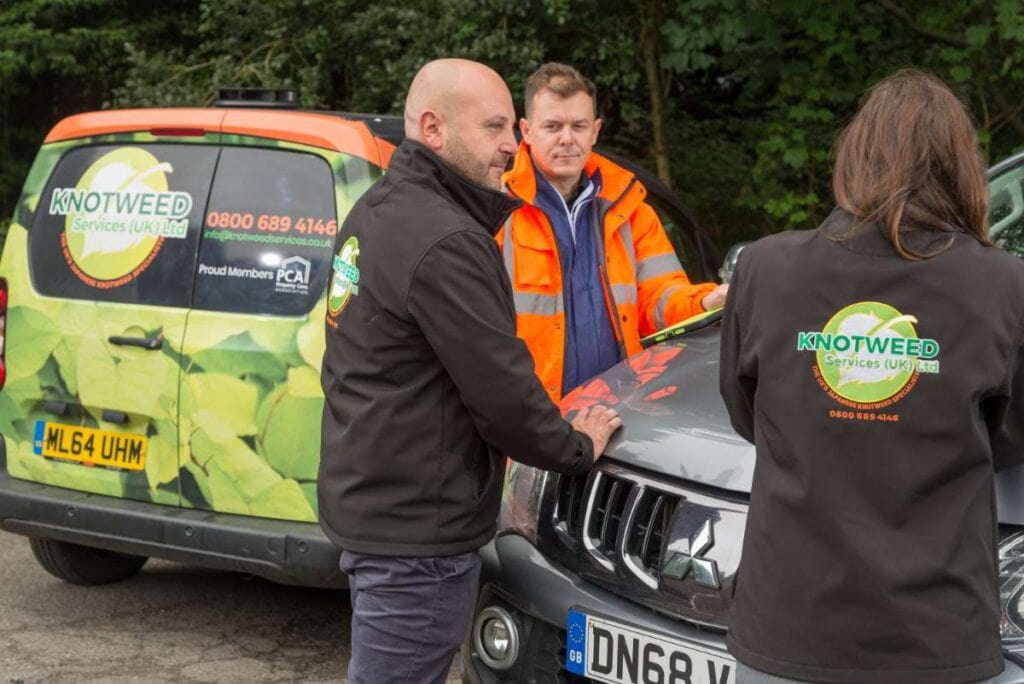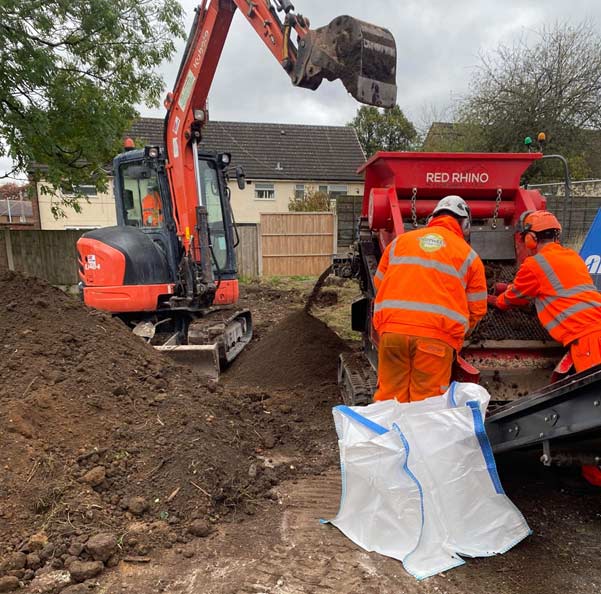JAPANESE KNOTWEED REMOVAL Whitchurch
9
LIVE KNOTWEED JOBS IN Whitchurch
67
SUCCESSFUL KNOTWEED REMOVAL PROJECTS IN Whitchurch
100%
SUCCESSFUL PROPERTY SALES AFTER TREATMENT
9
Whitchurch BASED KNOTWEED STAFF
NO OTHER JAPANESE KNOTWEED COMPANIES IN Whitchurch HAVE OUR TRACK RECORD
Our specialist teams of qualified surveyors travel throughout Whitchurch to provide advice, assistance, and solutions for your Japanese knotweed problems. We offer efficiency, reliability, and value with our tailored solutions for all your Japanese knotweed needs.
Knotweed Services is an approved member of the PCA, a government-recognized organization whose members provide the best methods for removing Japanese knotweed.
Knotweed Services has removed thousands of Japanese knotweed plants in and around Whitchurch and the surrounding areas. We use only the most effective treatments to ensure that your knotweed problem is completely eradicated.
Overview of Japanese Knotweed
Japenese Knotweed has many negative impacts on the properties it infests. Mortgage lenders are usually unwilling to lend against homes that have an infestation. This impacts both buyers and re-mortgagees because these lenders will not lend against the property.
If you’re a commercial land or property owner and Japanese Knotweed is present, your project may end up being delayed until your infestation is addressed correctly and legally.
Protect Your Property from Japanese Knotweed
- Japanese knotweed can grow through tarmac and concrete, posing a threat to your building or property.
- If Japanese Knotweed is present in a property, mortgage lenders often refuse to lend against that property.
- Knotweed grows so thickly as to block visibility and access to paths, highways, and other infrastructure. Knotweed is a particular nuisance for commercial properties.
If you live in Whitchurch and have knotweed, you should call Knotweed Services first. Our licensed specialists will remove the knotweed completely and guarantee that it will not return. We will also dispose of the removed plant material legally.



FREE IDENTIFICATION
Fill in the form below, attach your pictures and we’ll let you know if the plant in your picture is Japanese Knotweed.
Call us now to start the treatment and management of your infestation in Whitchurch
Call us on: 0121 725 6348 or 0800 689 4146 for an immediate quote
Knotweed Services will support you from the moment you decide to hire us.
RESIDENTIAL JAPANESE KNOTWEED REMOVAL Whitchurch.
WHAT YOU NEED TO KNOW ABOUT JAPANESE KNOTWEED REMOVAL Whitchurch
Because Japanese knotweed infestations vary so greatly, different treatments and control methods may be required.
Our weed control professionals study your property’s specific factors to determine the right methods to control the weeds. We guarantee every job we do.
— JAPANESE KNOTWEED REMOVAL OPTIONS AVAILABLE IN Whitchurch

FOLIAR SPRAYING *
Most common treatment. The spraying of powerful chemicals with a knapsack. We ensure that other plants aren’t damaged. The most effective time for foliar spraying to Japanese Knotweed is in Spring.

FOLIAR LEAF WIPING *
With this Japanese knotweed treatment we employ a device to ‘physically wipe’ our chemicals onto the Japanese Knotweed leaves. This application is so precise that we can often use a higher concentration of chemical.

STEM INJECTION
A measured amount of herbicide is applied directly to the invading plant. This is the most ingenious way of elimination because the herbicide is injected straight into the Japanese Knotweed. Not dependant on weather conditions.

BIOMASS REDUCTION
Biomass is a form of excavation and removal but instead of extracting all of the soil impacted by Japanese Knotweed, we only remove the infested parts of the soil. It’s an excellent Japanese Knotweed control method that allows the reuse of the soil. Reducing the use of landfill.

CROWN REMOVAL
Crown and stems can regenerate, and even small bits of chopped crown or stem can regenerate and become a new invasive weed; removing these from the equation is a fantastic method.
— COMMERCIAL TREATMENT OPTIONS AVAILABLE IN Whitchurch

SOIL SCREENING
A tried and tested methodology used on hundreds of sites across the UK.
Using the screening method, the Japanese knotweed rhizome material is separated from the soil material. The Japanese knotweed material is then either transported to licensed landfill at a much lower disposal rate or incinerated on site using a D6 exemption from the Environment Agency or Natural Resources Wales.
The cleaned soils can then be reused in locations away from any construction, normally in soft landscaping areas.
This can reduce the landfill & backfill requirement costs significantly and can also help to reduce the carbon footprint on site due to reduced vehicle movements to landfill.

BIOSECURITY SUPERVISION
To keep an eye on any digging or shifting of soil containing Japanese knotweed on your property, we can send a biosecurity worker.
We can set up a location where individuals can wash their boots and equipment at the site entry as a part of these precautions. We will supply the primary contractor with all toolbox discussions, which will be signed by all other contractors involved in the operation on site.
In locations where biosecurity is essential, we are able to offer temporary geotextile barriers.
After the service is over, we will deliver a thorough biosecurity report to the client.
This technique can be used in conjunction with other on-site therapeutic strategies.

EXCAVATION AND DISPOSAL
This treatment method is ideal where time constraints are present and there’s no other option other than to remove both the Japanese Knotweed and contaminated soil to a registered landfill.
By removing all traces of the infestation quickly, this offers a rapid solution to your problem and allows your commercial project to begin groundwork’s almost straight away. When time is of the essence, there is no quicker Japanese Knotweed removal/treatment method.
Any waste taken off-site will be done so with a licensed waste carrier to a suitably authorised landfill site.

CELL BURIAL
Cell burial comprises of moving Knotweed contaminated soil from one location on site, burying it in an excavated pit which is lined with a root barrier membrane, in a different position on the site.
The burial requirements for Japanese Knotweed are as follows:
- The Environment Agency recommends that the top of the burial cell should be a minimum of 2 metres below ground level.
- The overall depth of the burial pit should be in excess of 5 metres deep. All root barrier seams are welded together forming an encapsulated cell from which the Japanese Knotweed cannot escape. Clean soil is then used to backfill on top of the cell.
- To prevent accidental disturbance of the burial site, it is recorded on all site plans and future land owners should be made aware of the location.

STOCKPILE & TREAT
Bunding is the method of relocating contaminated Japanese Knotweed soil to a different area of the site being treated. A bund is a shallow area of the contaminated soil, typically 0.5m deep.
The bund can either be raised, on top of the ground, or placed within an excavation to make the surface flush with the surrounding area.
The purpose of the bund is to move the Japanese Knotweed to an area of the site that is not used. This ‘buys time’ for treatment that would not be possible where the Japanese Knotweed was originally located.

HERBICIDE APPLICATION
At Knotweed Services we can provide the client with bespoke treatment plans depending on the locations of the Japanese knotweed.
These plans can work in conjunction with other methods of treatment where access is limited to pedestrian movements i.e., embankments or existing pathways within a site.
This will normally consist of up to 3 visits per annum to apply herbicide by either foliar spray technique or stem injection during the growing season over a period of 3 years, with a monitoring period of 2 years thereafter.
We would select the appropriate herbicides depending on the surrounding foliage or environmental constraints.
After each visit a full treatment record would be provided with photos showing the progress of the works and then an annual report.
